On a warm, sunny July morning in Southern California, chefs will rise from their slumber to begin preparing for meal service for the day. The only thing different on this day is their preparations may not include foie gras, the heady, buttery and pricey substance manufactured through gavage (the practice of force-feeding waterfowl by inserting a tube down their throats and then harvesting their fatty, over-sized livers). Unless you’ve been taking a twenty-year nap on a hillside behind a Hudson Valley farm, you’re undoubtedly aware of the ban on the sale, purchase, or consumption of foie gras fabricated using the gavage technique. California State Senate Bill 1520 was passed into law in September of 2004 to take effect July 1, 2012; the reason for the bill’s lengthy gestation period was to allow farmers to find an alternate means of creating the rich, cholesterolic delicacy. Opponents of the law (primarily chefs who stand to lose revenue from the sale of the pricey mush) argue that the process isn’t cruel at all, as these birds do not have a gag reflex, have esophagi that relax and enlarge to allow large items such as fish go down their gullets and do not experience discomfort or pain. Unless the duck that was interrogated had Gilbert Gottfried’s voice, I’m not sure how they drew that last conclusion, but in hidden camera video of the feeding of these birds, it doesn’t look like a day at a picnic.
A gaggle of California chefs have banded together to form a coalition with the nifty acronym C.H.E.F.S. (Coalition for Humane and Ethical Farming Standards) in which they try to develop “less cruel” means of feeding and caring for the birds, as well as allow independent investigation and analysis of the practice in hopes that it can be scientifically proven that the process is not as cruel as it is purported to be. Nationally, celebrity chefs are throwing their support behind the local hash slingers – the group of opponents includes Ludo Lefebvre, Andrew Zimmern, Alton Brown, and Anthony Bourdain (although there are a few notable exceptions, such as Wolfgang Puck and Charlie Trotter). Melisse owner/chef Josiah Citrin posted a picture on Twitter that features a water bird with a fish bigger than its head sticking out of its gaping beak, accompanied by text reading, “this is what ducks feeding in the wild do. Does this look cruel to you?”; the post was retweeted by Andrew Zimmern, who lauded it as “Brilliant”. While I agree with Chef Citrin that the image of the bird feeding didn’t look cruel, I have to add several caveats: first off, the bird pictured is a cormorant, a fishing bird more akin to a pelican than a duck or goose; in addition, it didn’t look cruel because there wasn’t a human hand at the end of the fish pushing it down the cormorant’s throat. The picture was supposed to bolster one of the primary arguments put forth by opponents of the law – since these birds naturally over-eat, giving them a helping hand is perfectly legit.
Initially, California’s only foie gras producer (Sonoma Foie Gras) supported the measure, saying that if the production practice could not be supported or alternative could not be found after seven years, they would quietly fade into the California sunset (the farm closed just prior to July 1 as agreed). To a certain degree, the opponents of the bill are correct in their observation that the waterfowl will naturally over-eat, but their argument also works against them when considering the term “naturally”. Internationally, some farms are able to allow the birds to feed freely without having to gut load them by letting them be snow birds. As the seasons change and geese and ducks prepare to winter in Boca Raton they chow down like a busload of corn-fed Midwesterners stopping at a roadside Golden Corral, only they find that instead of first-class accommodations on Delta they’re given a one-way ticket to the abattoir. The problem with this natural process is that in a climate where the seasons favor year-long avian cavorting the birds have no reason to stock up for winter. In a discussion I had with Chef David McMillan of Joe Beef in Montreal, he recalls how foie gras was always a special treat around the winter holidays and that it was unusual to find it served other times of the year; modern foie gras farms can produce it year-round using gavage, and with the sheer number of high-profile chefs accommodating the tastes of wealthy foodies, the demand creates a constant market.
In an 11th hour Hail Mary attempt to revoke or postpone the ban, C.H.E.F.S and other opponents approached California legislators to champion their cause, but the reaction they received was less than warm and eager – most responded with a resounding “No” and chided that they should have opted not to make hay while the sun shone; not a single legislator sided with the chefs. In the two months prior to the ban’s enactment, California chefs have been hosting top-dollar foie gras feasts that demonstrate that waterfowl aren’t the only creatures capable of excess with the proceeds of these face-stuffing foie fests going towards funding C.H.E.F.S’ legal battle. Chef Laurent Quenioux (the Gary Hart of California chefs) stated publicly that he has no intention of complying with the ban; he would do well to speak with chef Kiyoshiro Yamamoto who saw his place of employment closed down after serving animal rights ninjas whale meat at Santa Monica’s Hump restaurant. The fine for violating the ban brings a fine of up to $1,000 per violation per day (which makes that some pretty expensive foie gras).
In some cases, the argument has been put forth that gavage is not as cruel as practices of factory farms such as feed cages and dismemberment, and while this may be true the question remains – would you rather be shot in the toe with a .22 or in the ass with a bazooka if your third choice is to remain intact? Gavage is admittedly low hanging fruit, small potatoes with only a single practitioner in all of California, but regardless, the practice is still outlawed. Senate Bill 1520 makes California the only state to ban foie gras made by force-feeding, and although chefs are hoping it is repealed as was a similar measure by the City of Chicago, the key difference is that they quite frankly don’t have a large support base; foie gras is a dish enjoyed primarily by the wealthy, and the 1 percent won’t miss what they haven’t had an opportunity to experience. Some chefs such as Perfecto Rocher of L.A.’s Lazy Ox Canteen have elevated that apathy to an art form, offering a cavalcade of liver dishes during foie gras’ last hurrah that don’t include duck or geese livers; perhaps this is the wave of the future, although some chefs are planning to exploit a loophole in the law by offering expensive dishes that feature “free” foie gras as an accoutrement.
In case I haven’t stated this previously, I am a card-carrying omnivore; I have had the pleasure of consuming foie gras in the past, as well as other items that have since been banned in the State of California; I have to ask where C.H.E.F.S. was each time these items were banned:
First they came for the horse meat and I didn’t speak out because I wasn’t a slaughterhouse owner.
Then they came for the shark fin soup and I didn’t speak out because I wasn’t a Chinese chef.
Then they came for foie gras and there was no one left who cared.

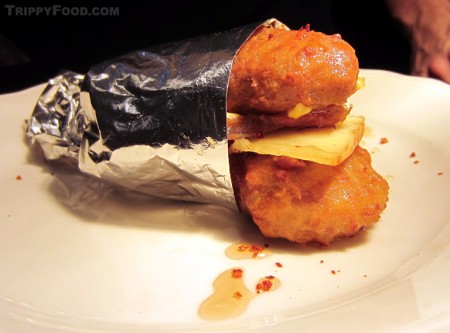
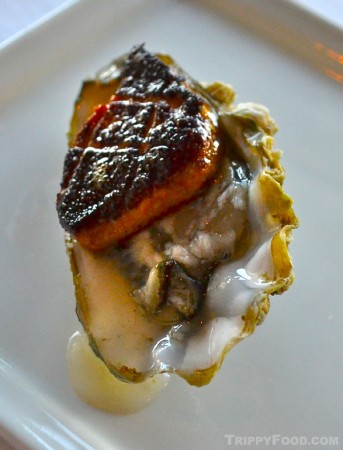
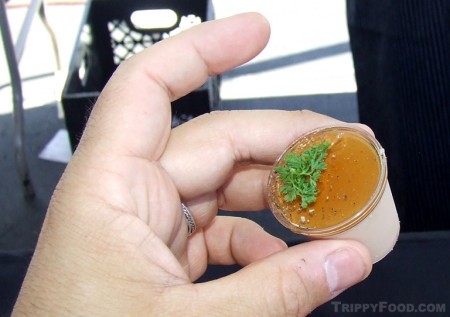
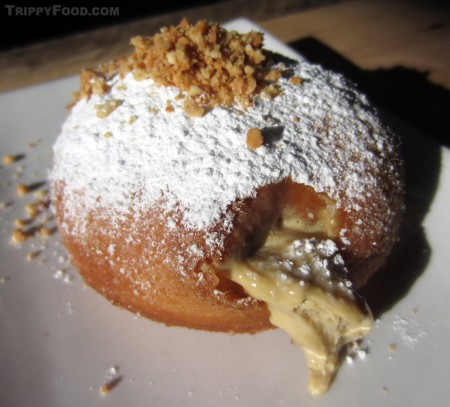
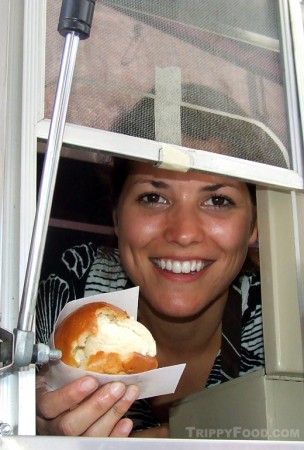

Brilliant!
Thanks, Eddie. The ban has taken effect and oddly enough the sun still rises and sets…
I wonder if someone did this to Quenioux or someone he loved, if he would still feel the law “doesn’t make sense.” (What he told Businessweek along with “I have no intention of following the law.”) <>
Lolana,
Personally, I don’t know whether or not waterfowl at a farm where gavage is employed as humanely as possible encounter distress or not; obviously a foie gras manufacturer who treats the animals the way corporate factory farms do needs to clean up their act. I do believe that gavage is as unnatural as the process used to raise veal cattle, and although I enjoy foie gras I won’t go out of my way to defy the ban (I won’t turn it down in places where it is legal). As I stated in the article, there’s a natural way to do it that limits production to a seasonal treat, but farms in climates where the birds don’t naturally prep themselves for winter or have to keep up with the year round demand are going to have some problems using natural methods.
That having been said, I have to take issue with your comment about Chef Quenioux; it seems to me that animal rights activists that devalue human life over the treatment of animals might not truly understand the definition of the word “humane”. To wish harm on someone because of their beliefs or exercising free speech (Chef Quenioux is not personally shoving anything down anyone or anything’s throat) is contrary to the belief that all life should be valued. If you think torture, mistreatment, killing, etc. is wrong, then you present a hypocritical view point when advocating the same towards people. If you truly believe that these creatures are being mistreated, then work towards ending the practice in the same spirit of humanity you are demanding, otherwise you place yourself in the same category as those you criticize.
Lolana, I’m not sticking up for Chef Quenioux’s statement that the law “doesn’t make sense”, but we have to separate the restrictions of the law with the issue of what is considered cruel treatment – they’re two separate issues. Suggesting harm to human beings in response to potentially inhumane treatment of animals by the manufacturers (Quenioux isn’t force-feeding waterfowl) is in itself inhumane. Cruelty is never an answer to cruelty.